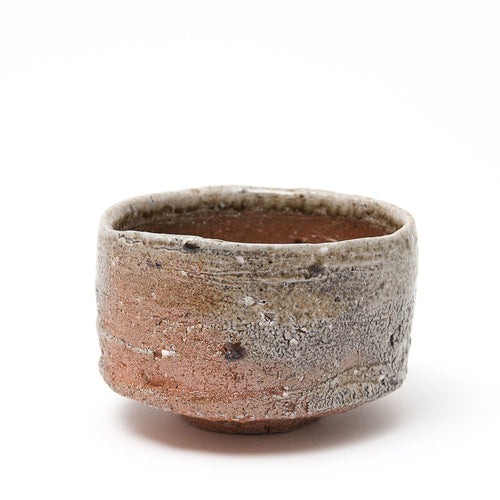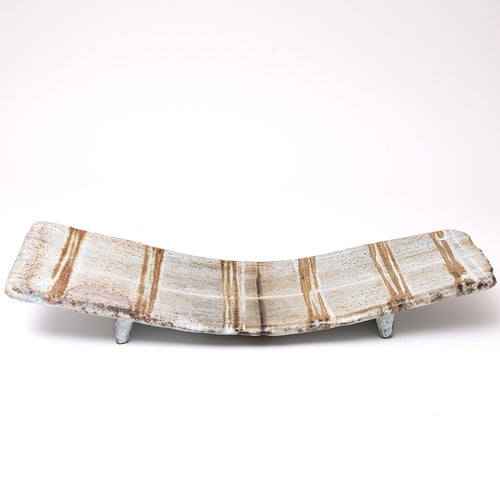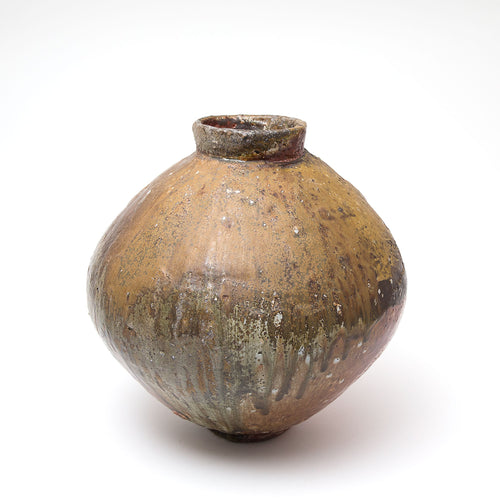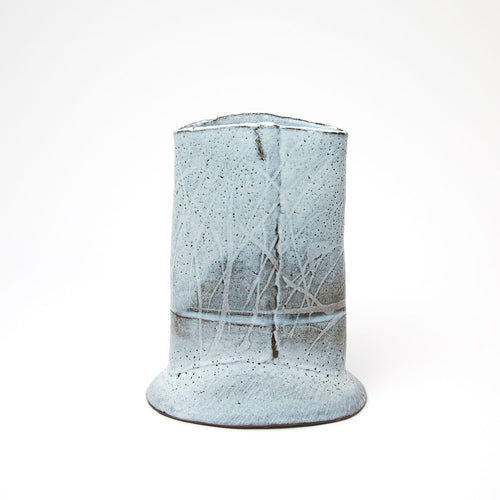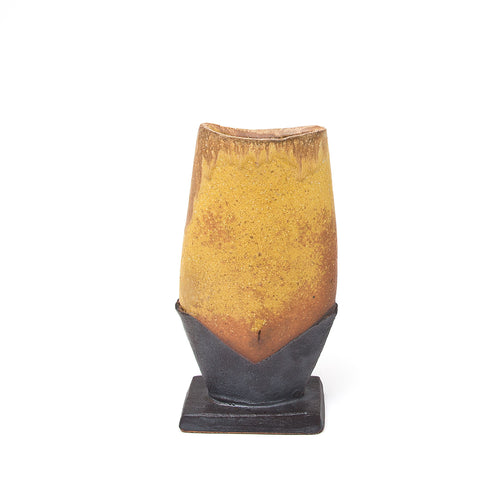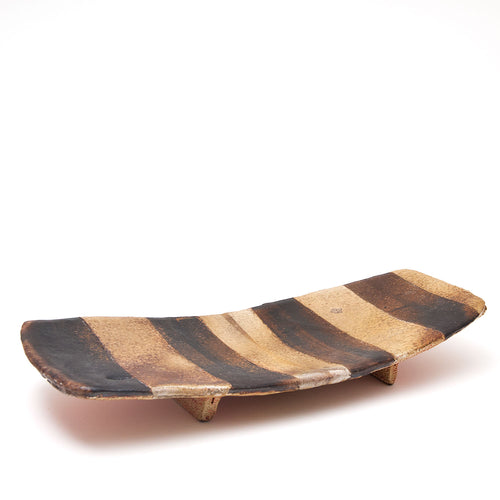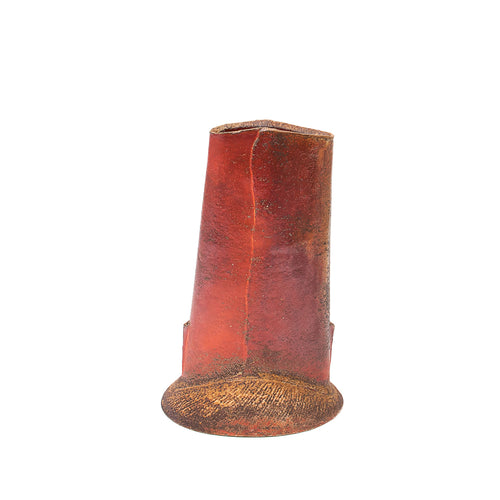A half century ago the British novelist and physicist C.P. Snow commented on the yawning chasm he felt separated what he called the two cultures, that is, the sciences and the humanities. As a young man Randy Johnston moved across that divide, and the catalyst for his shift was clear: Warren MacKenzie.

Johnston was headed toward a career as a medical doctor or marine biologist – Jacques-Yves Cousteau was an early hero – when he went in search of a photography course and wound up in an introductory ceramics class instead. MacKenzie was the teacher, and he has been an important figure in Johnston’s life ever since as a mentor, role model, and friend. Turning toward art and away from science does not necessarily mean completely abandoning one for the other. That is especially true with ceramics, with its technical side encompassing such important matters as kiln construction and firing temperatures, clay bodies and glaze formulas.

It is even possible that for many potters the technical, analytical aspects of ceramics are an essential part of the appeal, the perfect complement for the expressive, imaginative elements. Ceramics, like photography, enables practitioners to draw upon both the right and left side of the brain in a kind of internal dialogue. Johnston does display some qualities identified with the scientific method: he is organized, a deliberate worker, and a problem-solver who welcomes a good challenge. Yet his love of wood firing suggests a willingness to court chance as well as assert control.
 Johnston's anagama-style (single-chambered wood firing) kiln (dubbed 'the raging adolescent')
Johnston's anagama-style (single-chambered wood firing) kiln (dubbed 'the raging adolescent')
No matter how careful the preliminaries, there always remains the ceramic leap of faith involved in surrendering work to the fire for the final stage of creation. A firing may be a kind of experiment, and it may be more than a figure of speech to discuss scientific and mathematical theories or proofs in terms of elegance and beauty, but the scientific pursuit of definitive truths about nature is not the same as the aesthetic search for possibly ambiguous and metaphorical truths about human nature – and Johnston made his choice long ago.
 Squared and lobed Vase, with natural ash from the anagama firing
Squared and lobed Vase, with natural ash from the anagama firing
Born in 1950, Johnston is, chronologically speaking, a child of the mid-century. His work can be far from what is usually taken as mid-century modern – clean-lined Scandinavian designs, or International Style modern architecture, all glass and metal and right angles.
 Johnston's woodland house in rural Wisconsin
Johnston's woodland house in rural Wisconsin
Still, Johnston represents that historical moment as both a ceramicist and a modernist. As a ceramicist, because he in effect belongs to the third generation of the modern studio pottery movement, following Bernard Leach and then MacKenzie (and MacKenzie’s contemporary, the Japanese master Tatsuzo Shimaoka, with whom Johnston apprenticed).
 The extraordinary view from the studio windows
The extraordinary view from the studio windows
As a modernist, because his artistic vision extends beyond ceramics to other art ascendant at the time, New York School painting and sculpture. It is also strongly shaped by the early 20th century avant-garde, including the revival of interest in archaic and non-Western art that accompanied the rise of modernism.
 Large dish, with trails over rope coil textured decoration
Large dish, with trails over rope coil textured decoration
Johnston has for a long time demonstrated an individual style, with a recognizable, if constantly evolving repertory of forms. The most notable feature may well be the sense of physicality. Johnston’s work often appears monumental, but never ponderous. Johnston likes to match assertive physicality with equally bold surface treatment – thick-flowing black and white ribbons set against earth-toned backgrounds, punctuated by bursts of brighter colors like small eruptions.
 Large rectangular platter with natural ash and slip-trailed decoration
Large rectangular platter with natural ash and slip-trailed decoration
The designs can attain a remarkable complexity, as on a platter that may be regarded as a purely abstract emblem, loaded with mythical possibilities, yet also manages to suggest a landscape view with layered mountain ranges or perhaps a glimpse of a galaxy whirling at the edge of the cosmos.
 Nuka sushi platter with brushwork decoration
Nuka sushi platter with brushwork decoration
There is another side to Johnston’s sensibility, however, visible in more lyrical works with white-on-white surface treatments, often delicate linear designs that conjure up rain, or grass and plants blowing in the wind. Similarly, while the sturdy slab constructions rely on a meticulous, slow process, with yunomi and tea bowls a sense of immediacy is essential, so Johnston works more freely, to achieve a sense of ‘grace and casualness.’
 Nuka yunomi with iron brushwork
Nuka yunomi with iron brushwork
Whether working in a heroic or a lyric key, Johnston always seems to find a way to create a sense of visual drama. He will place a raised seam slightly off-center on a vessel form to introduce tension, splitting the space with the kind of ‘zip’ effect identified with the painter Barnett Newman. Or he will exploit the contrast between top and bottom, as in the full-bodied storage vessels, where he uses his experience with the wood kiln to develop a division between heavily fire-affected areas above and relatively untouched areas beneath.
 Tall squared vase form, with natural ash, crackle shino, and brushwork
Tall squared vase form, with natural ash, crackle shino, and brushwork
In a work with its vertical shaft divided into alternating light and dark bands, the precise geometry sets off the dark fluid form pouring down the side; in a spectacular bonus, near the bottom colored streaks appear in that luscious spill.
 Squared vase with broad, black stripes and crackle shino
Squared vase with broad, black stripes and crackle shino
This effect, as Johnston notes, could not have been predicted, and it is not the only recent case where the blessings conferred by the kiln show why wood firing can be so seductive. An oval form carefully placed to catch the kiln’s flow of fire and heat on an edge exceeded expectations by emerging with two brilliant yellow areas that sing out, while the extraordinary textures and layering on the surfaces of other works provide a kind of deeply compelling, endlessly fascinating abstraction that belongs to ceramics alone.
 Triangle bowl with shell mark and natural ash
Triangle bowl with shell mark and natural ash
Now that Johnston is no longer teaching, he has more time to explore some of the many ideas that have engaged him over the years. The complex nature of his process is evident in how his long-term interest in the work of two great early modern artists has affected his recent work.
 Multiple spoon form with copper green glaze
Multiple spoon form with copper green glaze
First, there are the elegant concave works indebted to Giacometti’s Spoon Woman (itself influenced by the Dan people’s ceremonial spoons). They include small raised elements like handles that almost make them seem like versions of tribal artifacts, for winnowing or grinding perhaps. But in fact the raised elements had their origin in the vertical nose forms on Cycladic sculptures, which Johnston shifted to the horizontal, a reminder of how an artist’s sense of formal necessity can generate its own logic.
 Boat form with copper glaze and herringbone coil texture, reminiscent of Shimaoka's characteristic impressed rope coil decoration
Boat form with copper glaze and herringbone coil texture, reminiscent of Shimaoka's characteristic impressed rope coil decoration
The surface treatments, subdued rather than expressionistic, further reveal Johnston’s artistic method as he tries different options: parallel lines in one, a herringbone pattern in another that recalls Shimaoka’s signature imprinted cord effects, and a white version that conjures up a ghost-like stringed instrument (or a grove of saplings), with a horizontal dark line to provide counterpoint and reveal once again Johnston’s finely calibrated sense of division and proportion.
 Nuka platter with brushwork
Nuka platter with brushwork
Johnston’s recent works also display a fascination with pedestals, inspired by Brancusi, that shows how a focus on a single element can shape an entire series. For Brancusi, a pedestal was not a minor adjunct to the sculpture but an integral element. Johnston has often used supports to maintain stability, as can be seen in the beautiful recent work that incorporates three shallow, dish-like forms set at different angles.
 Johnston working on the final touches of a triple spoon form dish in his studio
Johnston working on the final touches of a triple spoon form dish in his studio
(These forms, in another display of Johnstonian transformation, derive from Chilean winemaking tools; though made of clay, their surfaces suggest well-worn wood or metal.)
 Triple spoon form with copper glaze
Triple spoon form with copper glaze
With more vertical, vase-like forms Johnston became interested in exploring how the addition of a plinth-like base created a more figural, sculptural look: in some the base remains a conventional rectangular block separate from what stands above; in some the base is a curved continuation; and some are in effect both, as in the case of that astonishing fluid, frozen outpouring that links the banded sculpture and its base. Finally, there is the work that consists of a base form, a rectangular slab, with deep gouged grooves – a demonstration of how the exploration of one element can lead in an entirely new direction, opening up new possibilities.
 Figurative shino pedestal vase with brushwork
Figurative shino pedestal vase with brushwork
Johnston’s teapots deserve comment because they reveal other aspects of his method and style. No delicate porcelain confections, they possess a characteristic rugged strength. They are not wheel thrown; Johnston uses paper patterns to create the individual elements before assembling the whole.
 Johnston assembling a teapot from templated sections of clay
Johnston assembling a teapot from templated sections of clay
They may at first glance appear almost willfully archaic and non-modern, with curves that avoid sinuous sleekness and other elements that present a disconcerting angularity. But a more extended look reveals a jazzy piece of rhythmic play, with visual drama once again provided by the carefully cultivated surface effects from the wood firing, with the lighter areas on top set against the darker ones below.
 Round teapot with kaolin flashing and natural ash over slip
Round teapot with kaolin flashing and natural ash over slip
The bulging, hefty handles are not the product of ergonomic research resulting in the perfect design for the perfect composite user, but imply a particular kind of firm grasp, with the irregularity adding character. The bend in the spout may suggest an elbow or knee, but actually derives from Minoan and early Iranian ceramics, in pots with bird-beak spouts.
 Squared teapot, inspired by cast iron kettles seen during Johnston's stay in Japan
Squared teapot, inspired by cast iron kettles seen during Johnston's stay in Japan
One favorite teapot design, with a rectilinear rather than curvilinear body, is based on Japanese cast iron tea kettles. Part of Johnston’s fascination with the Japanese original came from an unfinished, raw edge required by the casting process, but he was also intrigued by the incorporation of circle, square and triangle as basic elements, so that there is a geometrical, metaphysical concept embodied in the work’s physical form.
 Figurative pedestal vase with copper glaze
Figurative pedestal vase with copper glaze
That brings us full circle, back to the relationship between the two cultures. Johnston’s interest in the intersection of mathematics and art, whether in the geometry of a teapot or the possible application of the Golden Spiral and Fibonacci figures to a curve, is too particular and personal to neutralize Lord Snow’s warning about the general separation between the sciences and the humanities. But it does offer one more powerful reminder of how Johnston’s expansive vision is constantly bringing together past and present, the conceptual and the formal, in the service of his art.
Robert Silberman, 2018

